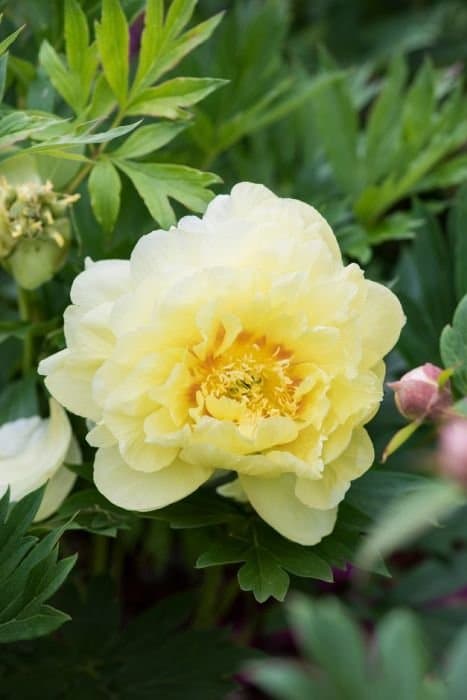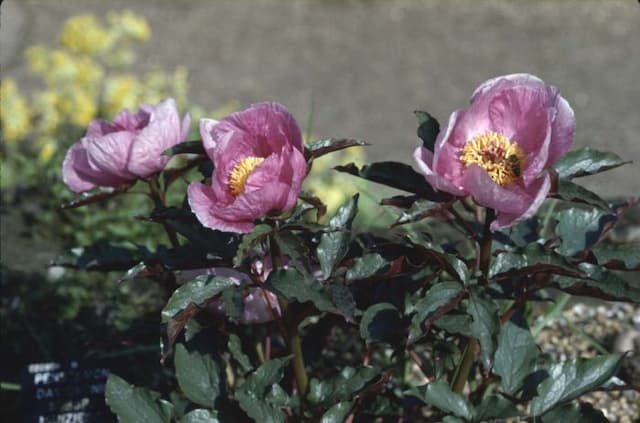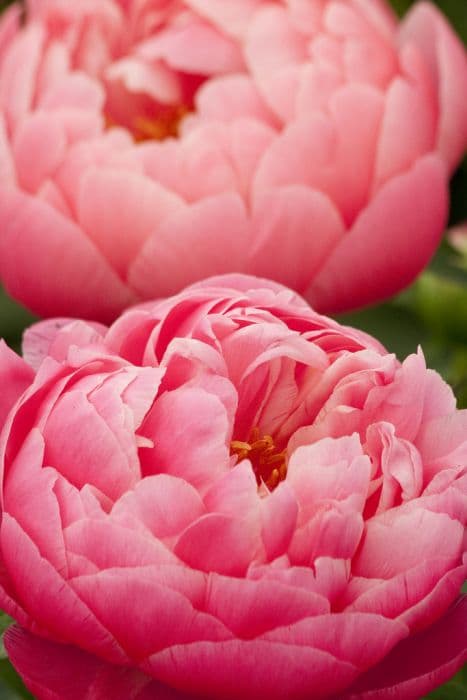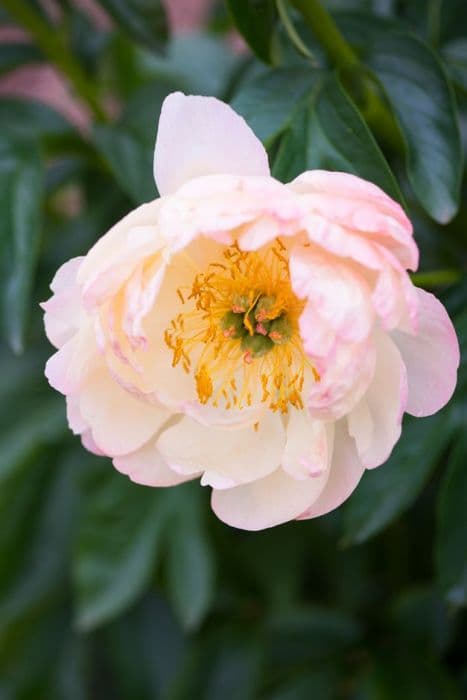Peony Paeonia lactiflora 'Karl Rosenfield'

ABOUT
The Karl Rosenfield peony is a perennial plant renowned for its stunning and opulent blooms. These flowers are particularly eye-catching, characterized by a deep cranberry red or magenta hue, and they display an enticing double form, meaning the flowers are full of layered petals. These petals possess a soft, silky texture and often glisten in the sunlight as if sprinkled with dew, adding to the visual complexity of the blooms. In the center of the flower, a cluster of smaller, golden-yellow stamens can usually be found, creating an appealing contrast to the red petals and adding an extra layer of color depth to the overall appearance. The plant itself is comprised of a robust, lush green foliage that serves as a rich backdrop to the dramatic flowers. The leaves are large, smooth, and have a somewhat shiny surface that reflects light, enhancing the plant’s vigorous appearance. The dark green color of the leaves contrasts beautifully with the striking red of the blooms, making the flowers stand out even more. While blooming, the Karl Rosenfield peony can become the centerpiece of any garden, providing a burst of vibrant color. Its flowers are not only a feast for the eyes but also emit a delightful fragrance – sweet and subtly perfumed – which can attract both admirers and pollinators alike. The scent is most pronounced on warm, sunny days and can fill the surrounding air, making the area near the blooms quite aromatic. Overall, the Karl Rosenfield peony is a classic garden choice, admired for its luscious, full blooms that evoke a sense of traditional elegance and beauty. Its striking presence is a highlight in spring to early summer gardens, and the plant is often used in floral arrangements and bouquets, especially favored for special occasions due to its lush appearance and enchanting fragrance.
About this plant
 Names
NamesFamily
Paeoniaceae.
Synonyms
Chinese Peony, Common Garden Peony.
Common names
Paeonia lactiflora 'Karl Rosenfield'.
 Toxicity
ToxicityTo humans
The peony is not commonly considered a toxic plant to humans. Accidental ingestion of peony parts typically does not result in serious poisoning. However, as with any plant material, individual sensitivities can vary, and consuming peony in large quantities could potentially lead to stomach upset or gastrointestinal discomfort.
To pets
The peony may be considered mildly toxic to pets, such as cats and dogs, if ingested. Symptoms of peony poisoning in pets might include vomiting, diarrhea, and drooling. In most cases, the consumption of peonies by pets will not lead to severe illness, but monitoring for signs of gastrointestinal distress is recommended and a veterinarian should be consulted if symptoms persist or are severe.
 Characteristics
CharacteristicsLife cycle
Perennials
Foliage type
Deciduous
Color of leaves
Green
Flower color
Red
Height
2-3 feet (60-90 cm)
Spread
2-3 feet (60-90 cm)
Plant type
Herb
Hardiness zones
3-8
Native area
Asia
Benefits
 General Benefits
General Benefits- Aesthetic Appeal: Peony 'Karl Rosenfield' is known for its large, double magenta flowers that add striking color and visual interest to gardens.
- Perennial Growth: As a perennial, it returns each year to provide beauty with less need for replanting.
- Attracts Pollinators: The flowers attract bees and butterflies, supporting local ecosystems.
- Low Maintenance: Once established, they require minimal care, making them ideal for gardeners of all levels.
- Long Bloom Period: It has a relatively long flowering period in late spring to early summer.
- Cut Flower Use: The blooms are particularly well-suited for creating vibrant and long-lasting cut flower arrangements.
- Cold Tolerance: Peonies are cold hardy and can survive in colder climates, making them suitable for many gardens.
- Deer Resistance: They are generally resistant to deer, which helps to prevent damage from wildlife.
 Medical Properties
Medical Properties- Antioxidant activity - Contains compounds that may help in protecting the body from oxidative stress.
- Anti-inflammatory properties - May reduce inflammation in the body.
- Immunomodulatory effects - Might influence immune system function and potentially boost immune response.
- Anti-tumor potential - Contains compounds that have shown activity against certain cancer cell lines in research studies. (However, further research and clinical trials are necessary to confirm efficacy and safety for cancer treatment.)
 Air-purifying Qualities
Air-purifying QualitiesThis plant is not specifically known for air purifying qualities.
 Other Uses
Other Uses- As a natural fabric dye: The petals of the peony can be used to create a natural pink dye for fabric, offering an eco-friendly option for textile coloring.
- In perfumery: The fragrance of the peony is extracted and incorporated into perfumes and scented products for its fresh floral aroma.
- As a cut flower in bridal bouquets: Peonies, including the 'Karl Rosenfield' variety, are popularly used in weddings for their lush, romantic blooms.
- In festive decorations: Peonies are commonly used in celebratory flower arrangements and decorations due to their large, showy flowers and symbolism of good fortune.
- In culinary presentations: The petals can be used as a delicate garnish for desserts and salads, adding a touch of elegance to the presentation.
- As a motif in art: Peonies are featured in paintings and designs, both for their beauty and symbolic meanings in various cultures.
- In photography: The 'Karl Rosenfield' peony, with its rich color and full form, is a popular subject for photographers capturing the essence of spring and floral beauty.
- For educational purposes: This plant can serve as a study subject in horticulture and botany programs, illustrating plant growth, reproduction, and hybridization techniques.
- In aromatherapy: Dried peony petals may be included in potpourri or used in sachets to impart a calming fragrance to linens and clothing.
- In ink production: Historically, peony petals have been used to create plant-based inks for art and calligraphy, although this practice is less common now.
Interesting Facts
 Feng Shui
Feng ShuiThe Peony is not used in Feng Shui practice.
 Zodiac Sign Compitability
Zodiac Sign CompitabilityThe Peony is not used in astrology practice.
 Plant Symbolism
Plant Symbolism- Honor: Paeonia lactiflora, commonly known as the Peony 'Karl Rosenfield', is often associated with honor and high esteem, frequently given in recognition of someone’s accomplishments.
- Prosperity and Wealth: Peonies are considered a good omen for financial success and are symbolic of wealth and prosperity, making them popular in celebrations and as gifts.
- Romance and Love: With their lush, full petals and rich color, peonies like 'Karl Rosenfield' are emblematic of romantic love and often used in wedding bouquets and decorations.
- Happiness and Joy: The vibrant and lush nature of the peony is associated with joy and happiness, symbolizing a cheerful spirit and good fortune.
- Beauty: The Peony is often seen as a symbol of beauty in many cultures, representing the ideal forms and aesthetic values.
 Water
WaterPeonies, including the 'Karl Rosenfield', require consistent watering, especially during the dry spells of summer. Water deeply once a week, providing about an inch of water through rainfall or supplemental watering. In general, this equates to roughly 0.6 gallons for each square foot of soil. It's important to avoid overhead watering to prevent fungal diseases—water at the base of the plant instead. During the fall, reduce watering as the plant prepares for dormancy.
 Light
LightThe 'Karl Rosenfield' Peony thrives in full sun to partial shade. It needs at least six hours of sunlight each day to bloom properly. The best spot for planting is in an area that receives morning sunlight and afternoon shade, especially in regions with hot summers, to protect the flowers from wilting.
 Temperature
TemperaturePeonies like 'Karl Rosenfield' prefer temperate climates and are hardy in USDA zones 3 to 8. They can survive winter lows down to -30°F and are quite cold-hardy. The ideal temperature for peonies is between 65°F and 75°F during their growing season. Peonies require a period of winter chilling (below 40°F) to set buds for the following spring.
 Pruning
PruningPrune 'Karl Rosenfield' Peonies in the fall after the foliage has died back to remove spent leaves and stems, which helps prevent disease. Cut the stems to just above ground level. Doing this once a year is typically sufficient maintenance for peonies. The best time to do this is after the first frost when the plant enters dormancy.
 Cleaning
CleaningAs needed
 Soil
SoilThe Peony 'Karl Rosenfield' thrives in well-draining, fertile, loamy soil with a pH ranging from 6.5 to 7.5. To create the best soil mix, combine equal parts garden soil, compost, and perlite or sand to ensure good drainage. Amend the soil with organic matter annually to maintain fertility.
 Repotting
RepottingPeonies like 'Karl Rosenfield' rarely need repotting as they are perennial plants that prefer to be undisturbed. They can remain in the same location for up to 10 years or more. Only repot or divide when the plant is overcrowded, typically after many years.
 Humidity & Misting
Humidity & MistingPeonies, such as 'Karl Rosenfield', are adaptable to a wide range of humidity levels typical of outdoor garden environments. They do not have specific humidity requirements and can thrive in average ambient humidity.
 Suitable locations
Suitable locationsIndoor
Provide bright light, cool temperatures, and proper planting depth.
Outdoor
Plant in full sun, well-draining soil, and space adequately.
Hardiness zone
3-8 USDA
 Life cycle
Life cycleThe life of a Peony 'Karl Rosenfield' begins with seed germination, which occurs in late winter to early spring, given stratification is completed to break seed dormancy. Following germination, root development and shoot emergence mark the establishment of seedlings, which may take several years to mature before flowering. Once mature, the perennial phase begins with vigorous growth in early spring as temperatures rise; foliage emerges followed by stems that develop into large, showy flowers typically by late spring to early summer. After the blooming period, the plant enters a phase of energy accumulation, storing resources in the root system throughout the summer. As autumn arrives, foliage begins to die back, signaling the plant's entrance into dormancy, which it maintains through the winter months. With the onset of the following spring, the cycle restarts with the peony exiting dormancy, resuming growth, and preparing for another season of blossoming.
 Propogation
PropogationPropogation time
Early spring
The most widely used method for propagating the peony, specifically the Paeonia lactiflora 'Karl Rosenfield', is through division. This method is typically done in the fall after the plant has gone dormant. Gardeners should carefully dig around the peony to lift the entire plant from the ground, gently shaking off any excess soil. The root ball should be divided into sections, ensuring that each division has at least three to five eyes, which are the small reddish buds found on the crown of the root. The divisions can then be planted in well-drained soil at a depth where the eyes are approximately 1 to 2 inches (2.54 to 5.08 centimeters) below the surface of the soil. It is crucial to provide ample water for the newly planted divisions to establish a strong root system before the onset of winter.









